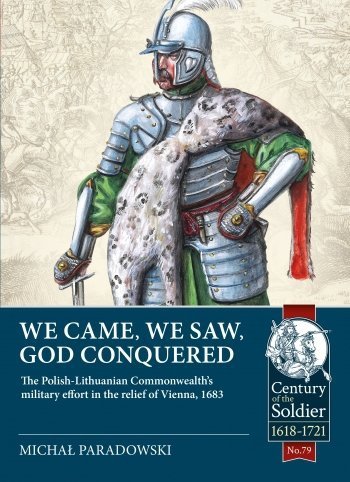-
Załączniki bezpieczeństwa
Załczniki do produktuZałączniki dotyczące bezpieczeństwa produktu zawierają informacje o opakowaniu produktu i mogą dostarczać kluczowych informacji dotyczących bezpieczeństwa konkretnego produktu
-
Informacje o producencie
Informacje o producencieInformacje dotyczące produktu obejmują adres i powiązane dane producenta produktu.HELION
-
Osoba odpowiedzialna w UE
Osoba odpowiedzialna w UEPodmiot gospodarczy z siedzibą w UE zapewniający zgodność produktu z wymaganymi przepisami.
The Polish-Lithuanian Commonwealth's military effort in the relief of Vienna, 1683
Series : Century of the Soldier 1618-1721 #79
Author : Michał Paradowski
Details
General - Pages : 248 | Images : 89 b/w ills, 16 b/w photos, 8pp colour plates, 6 maps, 50 tables
Paperback - Date of Publication : December 2021 | Size : 248mm x 180mm | ISBN : 9781914059742 | Helion Book Code : HEL1356
Earlier Polish experience from the war against Ottoman Turks in 1672-1676 made their contribution vital for the coalition’s war effort in 1683. No surprise then, that Sobieski was chosen as commander of the joint forces and that the Poles deployed on the ancient place of honour in an army’s order of battle – on the right wing. Many Polish researchers, like Jan Wimmer, Leszek Podhorodecki or Zdzisław Żygulski Junior (to name just few), have written extensively about the subject covered in this book, but unfortunately their works are not available in English. In this volume the author tries to present to English-speaking readers the Polish perspective of the battle and the role of the Polish army in the conflict.
There is much detailed information about the organisation and strength of the army that Jan III led on their march to relieve Vienna: the structure, weapons and equipment of the units, even down to company level. All formations, from the winged hussars to artillery, are covered. The background of the commanders – including not just the King but other high-ranking officers – are also presented. However, the book does not focus solely on the relief of the city. The remaining actions of the campaign in 1683 are also described, such as both battles of Párkány and the arrival of the Lithuanian army, together with Polish and Cossack actions in Podolia and Moldavia, which were forever in the shadow of the main events of 1683. Finally, the organisation and military actions of the troops under the command of Hieronim Augustyn Lubomirski, and raised as Imperial auxiliary division in Poland, is also covered.
The book is based on many primary and secondary sources, including diaries, letters and surviving muster rolls of individual units and the whole army. Many of these have not previously been available in English, and provide an extremely interesting insight into the seventeenth century views and observations of the army and the campaign.








